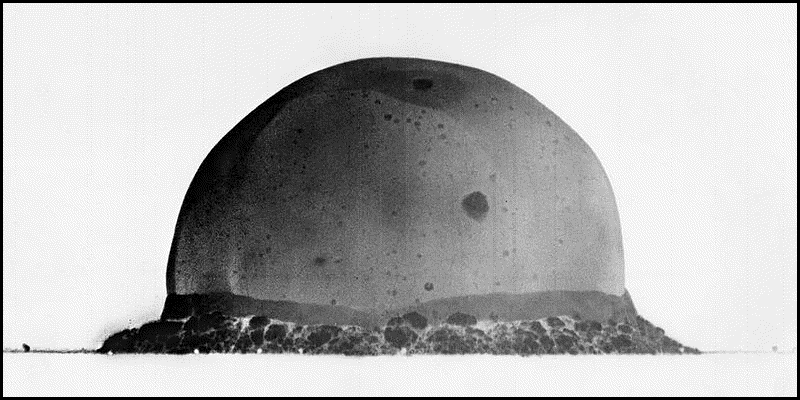
Field Note:
Alamogordo
February 2004

Alamogordo is like a seashore town with no water. No sea. Just the waves of the desert lapping up over the Walmart parking lot, drifting down the streets. Yesterday, the Trinity site. Our host was a colleague from New Mexico Tech in Socorro, and our tour guide was a public affairs officer from White Sands. The site itself is closed to the public except on the anniversary of the detonation, but we had accessed a back door. Julie and I arrive after spending several days in Albuquerque at the Atomic Museum, listening to docents set the record straight. It's all arithmetic for these guys. No ambiguity, no irony. A group of teenagers visibly yawning as they are told about the greatness of this achievement in American technical and humanitarian ingenuity. The kids' boredom is a simple and effective Darwinian response to the lies of adults. One can only hope that the dream-bird of the imagination is not far off for these young people.White Sands is vast, and most of what goes on there now is secret, much as what has already gone on there is secret. Apparently a great deal of terrorist research is conducted here now. A lot of "optics and surveillance work," I am told. "Purple Suit agency work" --- not sure what this refers to. Army, Air Force, and Navy.
We pass through a guarded gate and drive into the desert. It's a hundred miles to the other end, with God knows what in between. About five miles in from the gate, I hallucinate what seems to be an antelope in the desert brush. Not a Serengeti mirage, I'm told. "Just an oryx." It's a toss-up whether the word "just" or the idea of an oryx is more disturbing. "They were introduced in the 1960s," I'm told. Things were not weird enough. As we drive in from the north gate, somewhere out of sight is a scale model of the Alfred P. Murray Federal Building, otherwise known as the site of the 1995 Oklahoma bombing.
As we approach the site itself, we can see the imprint on the land. A light stain, almost imperceptible in the hard desert light; elliptical, a slight change in the tonal palette of the land. A depression in the earth, or a change in the vegetation? There is a large parking lot for the buses that arrive annually with veterans and journalists and "radicals." Off to one side is a large relic that turns out to be all that remains of Jumbo, the bomb enclosure that was never used.
The Trinity obelisk stands off to the side within a large, high-fenced enclosure. Oddly. Is this to keep people in, or out? Antelopes? It's much smaller than I had imagined --- the obelisk, that is --- but somehow this understatement makes it more, not less, hubristic. Perhaps seven feet? We are reminded that it is forbidden to take anything from the site, not that much remains. The ground, picked clean of the visible, still brings my Geiger counter to life.
As we enter the enclosure we can see that the ground has already been picked clean. It is curated with documentary images and captions placed at intervals around the fence. One can see an image of the base camp as it existed in 1945; the Macdonald Ranch, where the detonator was assembled, and from whose vantage point the detonation was viewed; the control-point bunker; the fully uniformed Trinity Site Polo team; Jumbo atop a train car; four thousand boxes of TNT used in a calibration detonation; Dr. Ken Bainbridge, the test-site conductor; a sequence of five images of the detonation beginning at .006 seconds; two post-blast images, one aerial and one on the ground. A few hot spots, but nothing much. It's all too powerfully understated. The effect is numbing. We return to Alamogordo, where we are to stay with relatives of one of Julie's students. Upon hearing of our visit the mother of our host invites us to her mountainside home. She has something to give us, apparently. This turns out to be a bag of trinitite and a plate of Serbian cookies. Both have family ties. The trinitite has been in a shoebox under her bed since her husband died. He collected it back in the days when there was no fence.
"Dear, you look like a geologist," she said.
--- From The Highway of the Atom
Peter C. van Wyck
©2010 McGill-Queen's University Press